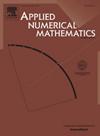Non trivial solutions for a system of coupled Ginzburg-Landau equations
IF 2.2
2区 数学
Q1 MATHEMATICS, APPLIED
引用次数: 0
Abstract
This article addresses both the existence and properties of non-trivial solutions for a system of coupled Ginzburg-Landau equations derived from nematic-superconducting models. Its main goal is to provide a thorough numerical description of the region in the parameter space containing solutions that behave as a mixed (non trivial) nematic-superconducting state along with a rigorous proof for the existence of this region. More precisely, the rigorous approach establishes that the parameter space is divided into two regions with qualitatively different properties, according to the magnitude of the coupling constant: for small values (weak coupling), there is a unique non-trivial solution, and for large values (strong coupling), only trivial solutions exist. In addition, using a shooting method-based numerical approach, the profiles for the nematic and superconducting components of the non trivial solution are given, together with an algorithm computing the transition values representing the boundaries for the weak coupling region: from superconducting to mixed, and from mixed to nematic. Finally, numerical evidence is given for the existence of a third region, related to neither a small nor a strong coupling parameter (medium coupling) for which multiple non trivial solutions exist.
耦合金兹堡-朗道方程组的非平凡解
本文讨论了由向列超导模型导出的耦合金兹堡-朗道方程组的非平凡解的存在性和性质。其主要目标是在参数空间中对包含表现为混合(非平凡)向列-超导态的解的区域进行全面的数值描述,并对该区域的存在性进行严格的证明。更准确地说,严格的方法根据耦合常数的大小将参数空间划分为两个性质不同的区域:对于小值(弱耦合),存在唯一的非平凡解,对于大值(强耦合),只存在平凡解。此外,采用基于射击法的数值方法,给出了非平凡解的向列分量和超导分量的分布,并给出了代表弱耦合区域边界的过渡值的计算算法:从超导到混合,从混合到向列。最后,给出了存在第三区域的数值证据,该区域既不涉及小耦合参数,也不涉及强耦合参数(中等耦合),且存在多个非平凡解。
本文章由计算机程序翻译,如有差异,请以英文原文为准。
求助全文
约1分钟内获得全文
求助全文
来源期刊

Applied Numerical Mathematics
数学-应用数学
CiteScore
5.60
自引率
7.10%
发文量
225
审稿时长
7.2 months
期刊介绍:
The purpose of the journal is to provide a forum for the publication of high quality research and tutorial papers in computational mathematics. In addition to the traditional issues and problems in numerical analysis, the journal also publishes papers describing relevant applications in such fields as physics, fluid dynamics, engineering and other branches of applied science with a computational mathematics component. The journal strives to be flexible in the type of papers it publishes and their format. Equally desirable are:
(i) Full papers, which should be complete and relatively self-contained original contributions with an introduction that can be understood by the broad computational mathematics community. Both rigorous and heuristic styles are acceptable. Of particular interest are papers about new areas of research, in which other than strictly mathematical arguments may be important in establishing a basis for further developments.
(ii) Tutorial review papers, covering some of the important issues in Numerical Mathematics, Scientific Computing and their Applications. The journal will occasionally publish contributions which are larger than the usual format for regular papers.
(iii) Short notes, which present specific new results and techniques in a brief communication.
 求助内容:
求助内容: 应助结果提醒方式:
应助结果提醒方式:


